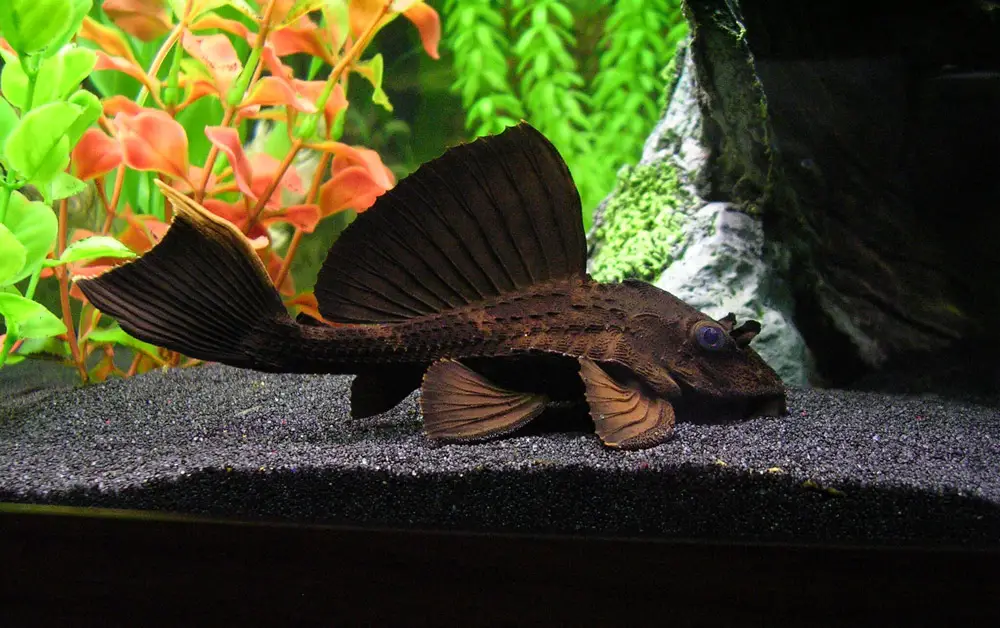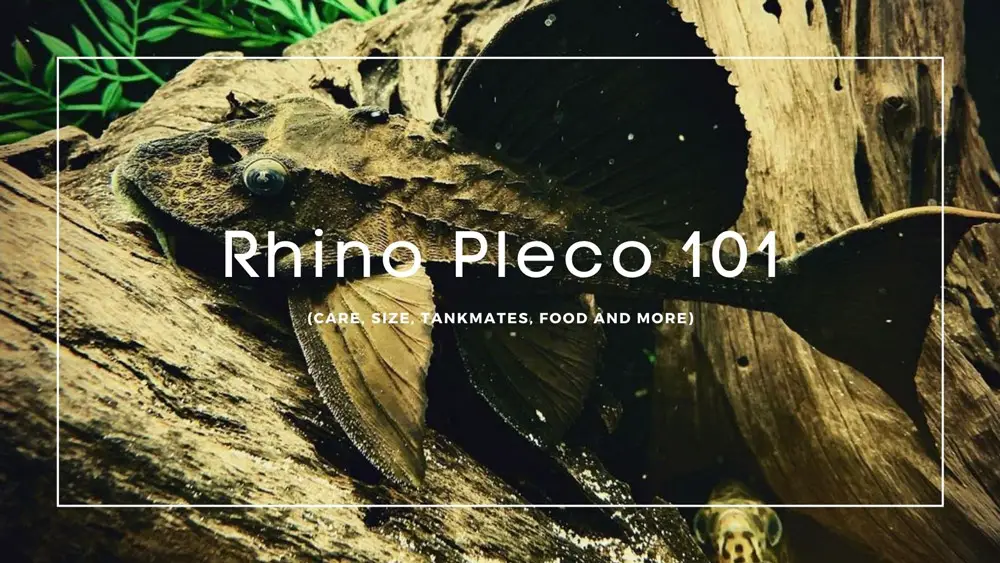Like most plecostomus, Rhino plecos are a preferred species among hobbyists because of their easy maintenance.
They eat a wide variety of food, and as long as the aquarium is clean with plenty of space for grazing – there shouldn’t be any problem keeping them!
For aquarists who are looking for a unique, friendly pleco, the Rhino pleco is a great option for just about anyone!
This rhino pleco care guide will cover all the required information there is to know about rhino pleco care. size, diet, tank setup, and more!
Let’s start then!
Species Profile
Also known as Pterygoplichthys scrophus, the tropical catfish species rhino pleco is often nicknamed “alligator pleco” or “chocolate pleco” by fishkeeping enthusiasts. It’s native to the Ucayali and Maranon river basins of Nanauta (Peru).
What Is The L-Number For A Rhino Pleco?
Rhino plecos aren’t associated with any L-number per se; let us explain why.
The numbering system, starting with 001, was discovered in the 1980s to recognize the scientifically unnamed species of the Loricariidae (pleco) family. This number comprises two parts- “L” for Loricariidae and the number. But since rhino pleco had been given its scientific name, i.e., Pterygoplichthys scrophus, the L-number doesn’t apply here.
| Scientific Name | Pterygoplichthys scrophus |
| Common Names | Chocolate Pleco, Alligator Pleco, Rhino Pleco |
| Origin | South America |
| Care level | Moderate |
| Size | 11″ |
| Temperature | 71-83°F |
| pH | 6.0 – 7.6 |
| Tank size | 75 gallons |
| Temperament | Peaceful |
| Diet | Omnivore |
| Suggested Tankmates | Any medium sized community fish |
Appearance

One of the most prominent physical features of rhino plecos is the “rays” on their dorsal fins.
While the bigger varieties, such as the Hypostomus species, usually have eight or fewer rays, rhino plecos and other subtypes of the Pterygoplichthys species have more than ten. In fact, you can easily differentiate between the two groups by observing the number of rays.
Other than that, they have two horn-like structures, which are actually the nasal flaps originating from their large nostrils. And the alligator-like ridges located on the side of their bodies give them the name “alligator” pleco.
Male Or Female Rhino Pleco- How to Identify the Sexing?
There are numerous ways to determine if a particular rhino pleco is a male or female. For one, the male fish is skinnier and overall shorter than its female counterpart. Besides, the latter has a more rounded abdomen, which is longer than the other parts of its body.
You can also confirm the sex by looking at the papilla of an adult fish. While males will have a small but broad stump protruding from the underside, females have a flatter papilla that almost lies on their bodies.
Average Rhino Pleco Size and Growth Rate
If you’re wondering, “how big do rhino plecos get?” Here is the short answer. A full-grown rhino usually attains a max size of 11 inches. There is no specific growth rate associated with their development, although some may grow by 3 to 3.5 inches in the first year.
Moreover, their color may vary between black and different shades of brown, like rich and dark, cinnamon, or a light and dark mottled hue.
Lifespan
The maximum lifespan of a rhino pleco is almost a decade, but it will ultimately depend on the quality of water and care provided. That’s why it’s important to create a proper aquarium environment and feed your plecos with the right food.
How To Care for a Rhino Pleco
What Do Rhino Plecos Eat?
Despite being termed omnivores, most rhino plecos love algae. They may even end up eating the floating plants in the absence of sufficient algae. Other than that, you can feed them:
- Sinking algae wafers
- Pellets
- Frozen or freeze-dried fish food
- Blanched green and leafy vegetables
- Fruits
- Shrimp
- Bloodworms and earthworms
Tank Size
The minimum recommended tank size for rhino plecos is 75 gallons, and we’d suggest keeping not more than two plecos in one. Remember that this species requires a large space to develop completely.
Water Parameters
The first thing to take care of is the water temperature, which should be between 72 and 82 degrees Fahrenheit. Aside from that, the pH level should range from 6.0 to 7.5 and the water hardness level between 5 and 19 dH with no ammonia, nitrate, or nitrite.
Common Possible Diseases
Ich
Ich is a parasitic disease that thrives in poor water quality. Its main symptoms are white spots on the fins and sometimes on the body.
Fin Or Tail Rot and Dropsy
Both these diseases are caused by bacteria harbored by dirty water and, in some cases, malnutrition. The primary symptoms of fin or tail rot include fatigue, appetite loss, and discord fins or tail that look melted. If your pleco appears bloated or discolored, then it may be because of dropsy.
Fish Fungus
Fungal infection like this often comes as an aftermath of an injury or scraped skin, where the fungus can breed and spread. That said, it may also be caused by low water temperature and irregular water changes.
Hole In the Head and Pop-Eye
Small holes on your pleco’s head and protruding eyes can be caused by a combination of factors, like poor water quality, low nutrition, and prolonged exposure to activated carbon.
Behavior & Temperament
The good news for would-be rhino pleco breeders is that they are generally a shy and peaceful species that gel with most medium-sized community fish varieties. However, they can get aggressive (especially with bottom-dwelling fishes) in a bid to procure their required space.
Again, this is a reason why you’d want a bigger tank for them. And if you want to keep other fish varieties, we’d advise going for the ones that can survive in the midwater or upper water levels to avoid overcrowding at the bottom.
Rhino Pleco Tank Mates
Some fish varieties that can peacefully coexist with rhino plecos are:
- Guppies
- Angelfish
- Mollies
- Loaches
- Platies
- Any other catfish species
- True Parrot Cichlid (Hoplarchus Psittacus)
Breeding & Reproduction
Unfortunately, there are no reports available about the breeding of rhino plecos in captivity. But it’s believed that these fish are cave spawners.
Final Thoughts
With that, we have come to the end of this guide.
Like any other pleco variety, rhino plecos also require regular maintenance and a conducive environment to survive. So, make sure that the water is well filtered and changed at the right time to prevent the onset and subsequent spread of diseases.
And if you spot the early sign of the diseases mentioned above, contact a vet at the earliest to figure out the best possible treatment.
